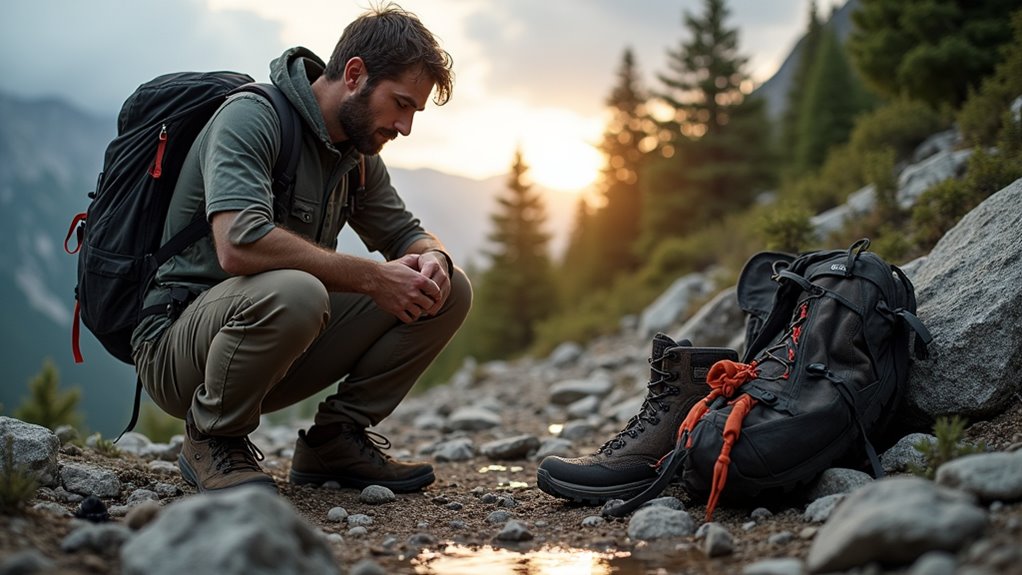Physical Address
304 North Cardinal St.
Dorchester Center, MA 02124
Physical Address
304 North Cardinal St.
Dorchester Center, MA 02124

Master the critical signs that signal it's time to abandon your hike before conditions turn deadly—your survival depends on it.
The wind suddenly picks up, sending leaves swirling around your boots as dark clouds roll across what was once a clear morning sky. You’re miles from camp, and something doesn’t feel right—whether it’s the weather, your energy levels, or that nagging voice in your head. Knowing when to turn back isn’t about giving up; it’s about making smart decisions that keep you safe. Sometimes the most important part of any hike is recognizing when it’s time to call it quits.

When dark clouds begin gathering on the horizon or winds suddenly pick up strength, you’re receiving nature’s early warning system that conditions are about to change. Don’t ignore these signals – they’re your cue to head back immediately.
Watch for rapidly dropping temperatures, which often precede severe weather. If you notice the barometric pressure shifting (your ears might pop), storms are likely approaching fast. Heavy, towering clouds that seem to build upward signal potential thunderstorms with dangerous lightning.
Pay attention to sudden wind direction changes or gusts that make you struggle to maintain balance. Animals going quiet or seeking shelter also indicate incoming bad weather. Trust your instincts when something feels off – it’s better to cut your hike short than face dangerous conditions miles from safety.
For expecting mothers, these weather warning signs become even more critical to heed, as pregnancy can affect balance and make navigating treacherous conditions more challenging.
While weather poses external threats, your body’s internal warning signals demand equal attention when deciding whether to continue or turn back. If you’re experiencing severe fatigue, dizziness, or unusual shortness of breath, it’s time to head back.
Don’t ignore persistent headaches, nausea, or muscle cramps—these often signal dehydration or electrolyte imbalances that can quickly worsen.
Pay attention to anyone in your group showing confusion, stumbling, or personality changes, as these indicate serious altitude sickness or heat exhaustion.
If someone’s experiencing chest pain, difficulty breathing, or signs of allergic reactions, turn around immediately.
Trust your instincts about physical limitations. There’s no shame in cutting a hike short when your body’s telling you it’s had enough.
Your body knows its limits better than your ambition does—listen to it and live to hike another day.
Better to return safely than risk a medical emergency miles from help.
Remember that recognizing these warning signs is especially crucial during family camping adventures when you’re responsible for the safety of multiple group members with varying experience levels.

Even the most reliable gear can fail at the worst possible moments, and certain equipment malfunctions should prompt an immediate return to safety.
If your headlamp dies without backup batteries, you’re risking navigation in darkness. A broken water filter or damaged water bottles can lead to dehydration or waterborne illness. Navigation tools like GPS devices or compasses that malfunction leave you vulnerable to getting lost.
Boot sole separation or broken hiking poles compromise your stability on challenging terrain. Torn rain gear during storms creates hypothermia risks. A failed stove means you can’t prepare hot meals or purify water when needed.
Don’t gamble with broken gear. Turn around when essential equipment fails, especially if you lack proper backups. Your safety depends on reliable equipment functioning when you need it most.
Following safer camping practices means always carrying backup equipment for critical gear and knowing when to prioritize safety over completing your planned route.
Though pride might whisper that you can handle anything, encountering trail conditions that exceed your current abilities is a clear signal to turn back.
Steep scrambles requiring technical climbing skills, river crossings with swift currents, or icy paths demanding microspikes you don’t have aren’t challenges to power through—they’re hazards that can turn deadly.
Your skill level isn’t fixed, but today’s hike isn’t the time to discover your limits. If you’re second-guessing whether you can safely navigate a section, that hesitation is your answer.
Experienced hikers recognize when conditions demand skills they haven’t developed yet.
There’s no shame in retreating. Every turn-around builds judgment that’ll keep you safe on future adventures.
The trail will wait.
Consider returning to camp and enjoying safer water activities that match your current comfort level instead.

Time becomes your most unforgiving hiking companion when daylight starts running short. You’ll need to make tough decisions about turning back, especially when you’re nowhere near your planned destination. Calculate your return time by doubling your hiking duration so far, then add extra buffer time for fatigue and potential delays.
Don’t push forward hoping you’ll move faster on the way back – you won’t. Your energy levels will drop, and terrain that seemed manageable earlier becomes more challenging in fading light. If you’re questioning whether you have enough daylight, you probably don’t.
Trust your instincts and start heading back early rather than risk orienteering unfamiliar trails in darkness. Before you turn around, take a moment to properly adjust your poles for the return journey to ensure maximum stability and comfort during your descent. Your campsite will still be there tomorrow.
Getting turned around on the trail ranks among hiking’s most serious concerns, and it happens faster than you’d expect. When you realize you’ve lost the trail or can’t identify landmarks, stop immediately. Don’t push forward hoping things will become clear—this usually makes matters worse.
When you realize you’re lost on the trail, stop immediately—pushing forward hoping for clarity typically worsens the situation.
If you’ve been off-route for more than 15 minutes without recognizing your surroundings, it’s time to turn back. Use your phone’s GPS or map to retrace your steps to the last known point.
When visibility drops due to weather, navigation becomes exponentially harder.
Trust your instincts when something feels wrong. If you’re questioning your location or the trail doesn’t match your expectations, head back to camp.
Getting lost extends your hiking time substantially and burns through daylight you can’t afford to lose. Proper trip planning before you leave camp can help prevent navigation issues by allowing you to study the route and identify key landmarks in advance.

When group members disagree about safety decisions or pushing forward despite risks, you’re facing a potentially dangerous situation that requires immediate attention. Different experience levels, varying risk tolerance, and peer pressure can create conflicts that compromise everyone’s safety.
If someone’s pushing to continue when conditions are deteriorating, or if less experienced hikers are being pressured beyond their comfort zone, it’s time to turn back. Watch for signs like arguing about route choices, ignoring weather warnings, or dismissing safety concerns as “being too cautious.”
Don’t let group dynamics override sound judgment. A strong leader should prioritize the group’s weakest member and most conservative safety assessment. Consider switching to safer activities like visiting top fishing destinations where the group can still enjoy the outdoors without the elevation and weather risks that hiking presents.
Beyond managing group conflicts, you need to recognize when your own mental state becomes a safety liability. Your gut instincts have kept humans alive for millennia—don’t ignore them now. If something feels wrong about the trail conditions, weather, or your group’s capabilities, trust that feeling.
Pay attention to your mental clarity. Are you making simple navigation errors? Feeling unusually anxious or overwhelmed? Having trouble concentrating on basic tasks? These signs indicate it’s time to turn back.
Fatigue affects judgment more than most hikers realize. When you’re mentally exhausted, you’ll miss important safety cues and make poor decisions. Don’t push through just because you planned to reach a certain destination. Your instincts are valuable safety tools—use them.
Remember that successful family camping requires prioritizing safety over ambitious hiking goals, especially when children are involved in your outdoor adventures.
You’ve got your smartphone GPS and all the modern gear, but sometimes Mother Nature calls the shots like an old-timey telegraph operator tapping out urgent messages. Don’t ignore her signals. Whether it’s nasty weather rolling in, your body hitting its limits, or gear failing when you need it most, there’s no shame in turning back. Your safety trumps any summit photo. Trust your instincts, communicate with your group, and live to hike another day.